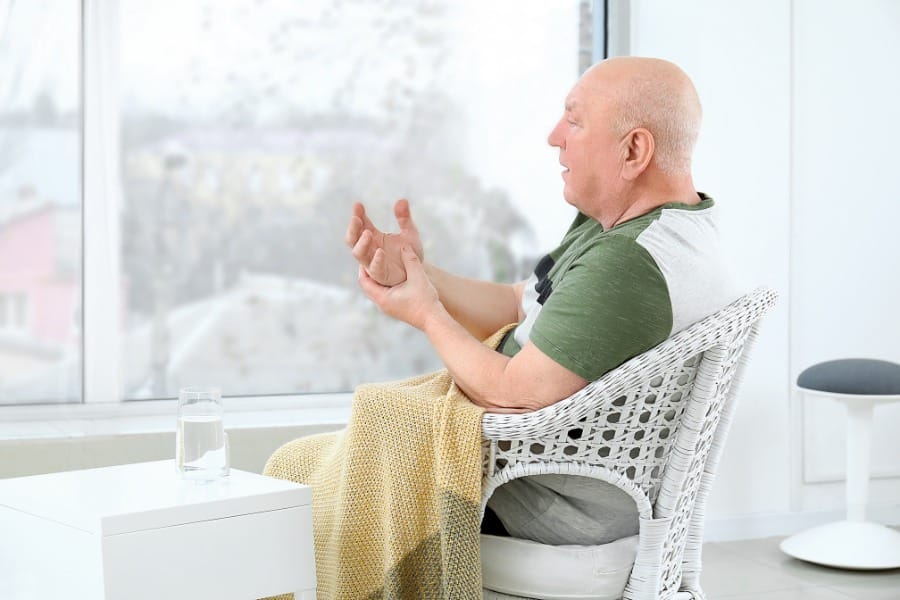Living with Parkinson’s disease can be a challenging journey, as this progressive neurological disorder gradually affects a person’s movement and overall well-being.
The root cause of Parkinson’s lies in the loss of specific nerve cells in the brain that produce dopamine, a crucial neurotransmitter responsible for regulating the body’s movement and coordination. As these cells deteriorate, individuals with Parkinson’s may experience a wide range of symptoms that can significantly impact their daily lives.
One of the most noticeable signs of Parkinson’s disease is the presence of motor symptoms, such as tremors, stiffness, and a general slowing of movement.
These symptoms can make simple tasks, like buttoning a shirt or walking, increasingly difficult.
However, Parkinson’s is not limited to physical manifestations alone; non-motor symptoms can also emerge, often in subtle ways that may be overlooked initially.
For instance, many people with Parkinson’s report a diminished sense of smell, which can occur years before other symptoms become apparent.
Sleep disturbances, ranging from insomnia to vivid dreams and even acting out during sleep, are also common. Additionally, cognitive changes, such as difficulties with attention, planning, and problem-solving, may develop as the disease progresses.
By understanding the diverse symptoms associated with Parkinson’s disease, those affected and their caregivers can be better equipped to manage the condition.
Recognizing the signs early on allows for timely interventions, such as medication, therapy, and lifestyle modifications, which can help maintain a higher quality of life.
Moreover, seeking support from healthcare professionals, support groups, and loved ones can provide invaluable resources and emotional support throughout the journey of living with Parkinson’s disease.
Key Takeaways
- Parkinson’s disease is a neurological disorder that affects movement and coordination due to the loss of dopamine-producing nerve cells in the brain.
- Symptoms can include both motor and non-motor aspects, impacting various aspects of daily living.
- Early recognition and understanding of symptoms can lead to better management of the condition and improved quality of life.
What is Parkinson’s Disease?
IN THIS ARTICLE

Parkinson’s Disease is a progressive neurological disorder that affects movement and can cause both motor and non-motor symptoms.
The disease is generally characterized by tremors, muscle rigidity, and difficulties with balance and coordination.
Causes and Risk Factors
While the exact cause of Parkinson’s Disease is unknown, it is believed to be a combination of genetic and environmental factors.
Age is one of the most significant risk factors, with symptoms typically appearing in individuals over the age of 60. However, early-onset Parkinson’s can occur in younger people.
Genetic factors also play a role in the development of Parkinson’s Disease. Several specific gene mutations have been identified as increasing the risk of the disease, but they are generally rare. Having a close family member with Parkinson’s may increase an individual’s risk slightly.
Environmental factors such as exposure to certain chemicals or toxins may contribute to the development of Parkinson’s Disease. Studies have suggested that long-term exposure to pesticides or herbicides might be a risk factor, but more research is needed to confirm these findings.
Diagnosis Process
There is no specific test to diagnose Parkinson’s Disease. In order to determine if a patient has the disease, doctors will assess their medical history, symptoms, and perform a neurological examination. This may include:
- Movement assessment: The doctor will observe the patient’s walking and coordination.
- Motor skills test: The patient will be asked to perform tasks such as buttoning a shirt or tapping their fingers to evaluate dexterity.
- Tremor evaluation: The doctor will check for the presence of tremors, specifically rest tremors that commonly occur in Parkinson’s patients.
- Medical history: The doctor will inquire about the patient’s personal and family medical history to identify any genetic risk factors.
It is important to rule out other conditions with similar symptoms, such as essential tremors or certain medications that may cause Parkinson’s-like symptoms. In some cases, imaging tests, like MRI or CT scans, may be conducted to help rule out other disorders.
By understanding the causes, risk factors, and the diagnosis process of Parkinson’s Disease, medical professionals can work to provide the most accurate diagnosis and develop an appropriate treatment plan to manage symptoms and improve the quality of life for patients.
Physical Symptoms of Parkinson’s Disease

Motor symptoms are common in Parkinson’s disease (PD), a movement disorder that affects the nervous system and parts of the body controlled by nerves.
These Parkinson’s symptoms can vary in severity and can significantly impact a person’s quality of life. This section will discuss the primary motor symptoms of Parkinson’s disease, including tremors, bradykinesia, muscle stiffness, and rigidity.
Tremor and Shake
Tremors are often the first noticeable symptom of Parkinson’s disease.
These involuntary, rhythmic shaking movements typically affect a person’s hands or feet but can occur in other parts of the body as well.
The tremors are more pronounced at rest and may be reduced or absent during voluntary movement or sleep [^1^].
According to the Parkinson’s Foundation, tremors can vary in intensity and can be worsened by stress or strong emotions. More often than not, it is these involuntary movements that are strong characteristics of Parkinson’s Disease.
Bradykinesia and Movement Difficulties
Bradykinesia, or the gradual loss of spontaneous movement, is another common symptom of PD. Affected individuals may experience difficulty with initiating movements, moving at a slower pace, and reduced fine motor control.
It may also manifest as decreased facial expression or masked facies, causing a “mask-like” appearance. The Mayo Clinic explains that bradykinesia typically develops slowly and the abnormal movements worsen over time.
Secondary to bradykinesia, postural instability can also occur. This involves difficulty in balancing and maintaining body posture, increasing the risk of falls and injury.
Gait difficulties, such as freezing or shuffling steps, may also develop as the disease progresses.
Overall, you can expect stiff muscles and slowness of movement as Parkinson’s Disease symptoms progress.
Muscle Stiffness and Rigidity
Muscle stiffness and rigidity are common motor symptoms of PD that affect the limbs, neck, and shoulders.
It may also impact facial muscles. Rigidity refers to the resistance felt when trying to move a person’s limbs or body, which can be painful and lead to a limited range of motion.
The National Institute on Aging states that these symptoms can contribute to difficulties with balance, coordination, and walking.
These can significantly impact a person’s quality of life, affecting their ability to perform daily activities and maintain their independence. Early recognition and appropriate management can help to alleviate some of these motor symptoms and improve the overall quality of life for individuals with PD.
Non-Motor Symptoms and Complications

Parkinson’s Disease is often associated with its motor symptoms, but many patients also experience a variety of non-movement symptoms.
These can significantly impact the quality of life for those affected. In this section, we will discuss cognitive and emotional changes, sleep disorders and fatigue, and autonomic dysfunction.
Cognitive and Emotional Changes
Cognitive changes are common among individuals with Parkinson’s Disease. These issues may include memory problems, slowed thought, and trouble focusing.
While tremors are a common symptom associated with Parkinson’s, a loss of sense when it comes to focus and memory are the second most prevalent.
In some cases, patients may develop more severe symptoms such as dementia, hallucinations, and delusions. Emotional changes are also a possibility, with depression and anxiety being prevalent in Parkinson’s patients.
It is essential for clinicians to closely monitor these symptoms and provide appropriate interventions.
Changes in Speech
Parkinson’s disease can affect speech in a variety of ways. Many people with Parkinson’s disease speak quietly and in a monotone, conveying little emotion.
Sometimes speech appears breathy or hoarse. People with Parkinson’s disease may slur words, mumble, or trail off at the end of a sentence.
Sleep Disorders and Fatigue
Sleep problems are often reported by those with Parkinson’s Disease. Patients may experience difficulty falling asleep, staying asleep, or achieving restorative sleep.
Sleep disorders, such as sleep apnea and restless legs syndrome, can further disrupt sleep patterns. In addition to sleep issues, fatigue may also hinder daily activities.
Daytime sleepiness and a lack of energy can make it challenging for patients to engage in routine tasks or maintain an active lifestyle.
Autonomic Dysfunction
Autonomic dysfunction refers to problems with the autonomic nervous system, which controls involuntary functions within the body. Parkinson’s Disease can cause disruptions in this system, leading to issues such as constipation, urinary problems, blood pressure issues, and sexual dysfunction.
For example, constipation is frequently reported by Parkinson’s patients, with the potential to induce further complications if left untreated. Urinary symptoms may include an increased frequency or urgency to urinate, incontinence, or difficulty in emptying the bladder.
Finally, sexual dysfunction may manifest as decreased libido, erectile dysfunction, or difficulties with arousal and orgasm. A healthcare professional can offer treatment options to manage these autonomic symptoms and improve the overall quality of life for Parkinson’s patients.
Living with Parkinson’s Disease

Daily Life and Management
Living with Parkinson’s disease means learning to navigate the challenges that come with this condition, but there are ways to maintain your quality of life and continue enjoying the activities you love.
One of the most important things you can do is to stay active and keep your body moving. Regular exercise, like taking a daily walk, doing some strength training while utilizing slow movements, or practicing Tai Chi, can work wonders for your mobility, balance, and coordination.
If you’re looking for more fun ways to stay fit, why not try swimming, cycling, or even dancing? Non-contact boxing is another great option that can give you both a physical and mental boost.
Of course, exercise is just one piece of the puzzle when it comes to managing Parkinson’s disease symptoms. Medication is also key, and it’s important to work closely with your healthcare team to find the right treatment plan for you.
They can help you monitor your symptoms, adjust your dosage as needed, and explore complementary therapies that may provide additional relief.
Another thing to keep in mind is the importance of creating a safe and comfortable home environment. Simple modifications, like installing grab bars in the bathroom, using non-slip mats on the floor, and keeping your living spaces clutter-free, can make a big difference in preventing accidents and allowing you to maintain your independence.
Living with Parkinson’s disease may require some adjustments, but with the right strategies and support, you can continue to live a fulfilling life and enjoy the things that matter most to you.
Support and Mental Health
A strong support system is vital for those living with Parkinson’s disease.
Family, friends, and professional caregivers can provide assistance in managing daily activities and offer emotional support. Connecting with others through Parkinson’s support groups can also provide a valuable network of people facing similar challenges.
Mental health is an essential aspect of maintaining overall well-being for people with Parkinson’s disease. Addressing emotional concerns and managing stress can impact the quality of life positively.
Seeking the guidance of a licensed therapist or counselor can help in developing effective coping strategies.
Private Nursing Care
We understand that assisting loved ones with PD can be stressful and overwhelming. It is a lot for a loved one to take on and assume the role of both family and caretaker.
Hiring a private nurse from NurseRegistry can peace of mind for both you and your loved one suffering from Parkinson’s Disease.
You can resume aspects of your life while knowing that your loved one is being taken care of by a professional, licensed, and empathetic nurse. We excel at caring for Parkinson’s patients at home.
Our nurses are the best of the best, we only work with RNs and LVNs/LPNs, and we meticulously match you with a nurse that fits based on personality, age, and gender.
Not to mention we offer industry-leading scheduling flexibility. That means you receive a nurse exactly when and where you need one – even for 24/7 care.
If you’d like to learn more about our in-home nursing care for Parkinson’s Disease, click below.
Frequently Asked Questions about Parkinson’s Disease Symptoms
What are the early indicators of Parkinson’s in individuals?
Early indicators of Parkinson’s disease include a barely noticeable tremor in just one hand, stiffness or slowing of movement, and difficulty with balance. Other common initial symptoms might involve changes in handwriting, reduced facial expression, and a shuffling gait.
How does Parkinson’s disease typically progress if left untreated?
Parkinson’s disease is a progressive disorder, which means the symptoms worsen over time. Initial symptoms such as tremors and muscle stiffness gradually increase in intensity, leading to difficulty in walking, balance issues, and eventually cognitive impairment. If left untreated, the individual’s quality of life will decline, and they may need support for daily tasks.
Can lifestyle changes improve or worsen the course of Parkinson’s disease?
Certain lifestyle changes can improve the quality of life for individuals with Parkinson’s disease. Regular exercise, healthy diet, practicing stress management techniques, and maintaining social connections can all positively impact the course of the disease. However, not all lifestyle factors can slow down its progression; it’s still crucial to follow a healthcare professional’s advice on medications and treatments.
What is the average life expectancy after a Parkinson’s disease diagnosis?
Life expectancy after a Parkinson’s disease diagnosis typically ranges from 10 to 20 years or even longer depending on factors such as age, overall health, and the severity of the symptoms. However, it’s important to note that this is just an approximation, and individuals may experience longer or shorter life expectancy.
What are the most effective treatments currently available for Parkinson’s disease?
There is currently no cure for Parkinson’s disease, but there are treatments available to help manage symptoms. Medications such as levodopa and dopamine agonists can help relieve motor symptoms by increasing dopamine levels in the brain. Other options include deep brain stimulation surgery for certain patients and physical, occupational, and speech therapies to help with daily living activities.
What are the signs that suggest a risk of developing Parkinson’s?
The exact cause of Parkinson’s disease is unknown, but there are some factors that can increase the risk of developing it. These factors may include genetic mutations, exposure to certain toxins, aging, and having a family history of the disease. However, having these risk factors does not guarantee the development of Parkinson’s disease.
What worsens Parkinson’s Disease?
Certain factors can contribute to worsening Parkinson’s disease symptoms. These may include stress, fatigue, and exposure to extreme temperatures. Furthermore, specific medications and substances, such as antipsychotics, may interfere with Parkinson’s disease treatments and cause a worsening of symptoms. It’s essential to consult with a healthcare professional before making any changes to medications or introducing new substances.






